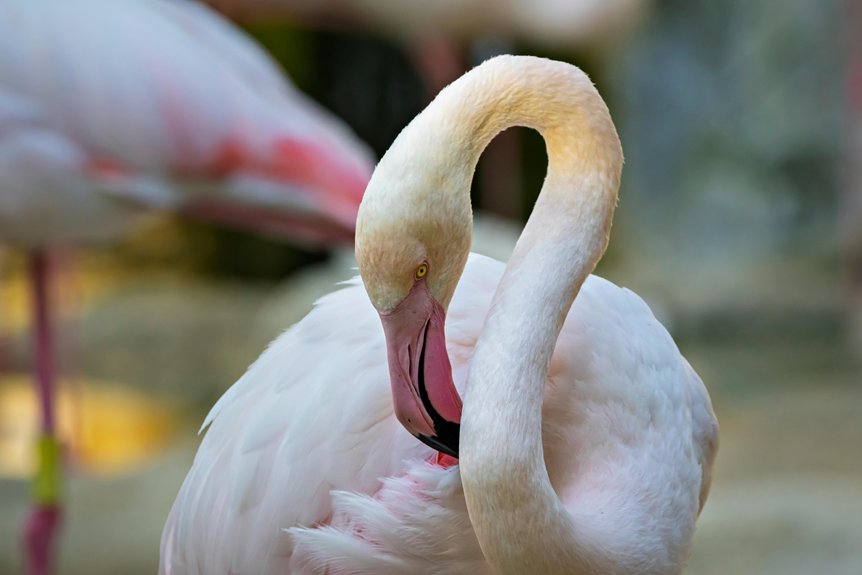When you visit Larnaca Salt Lake, following flamingo viewing rules isn’t optional-it’s essential. Your careful actions protect these sensitive birds from stress and disruption. Drones, loud noises, and close interactions can dramatically alter their feeding and resting patterns, threatening their survival. By maintaining distance, using binoculars, and respecting designated areas, you’ll help preserve this critical wintering ground. Curious about the deeper ecological impact? There’s more to uncover.
Wichtigste Erkenntnisse
- Prevent Stress: Disrupting flamingos through close approaches, drones, or loud noises causes significant physiological and behavioral stress that threatens their survival.
- Protect Critical Habitat: Larnaca Salt Lake is a vital wintering ground where flamingos feed, rest, and prepare for migration, requiring careful human preservation.
- Maintain Ecological Balance: Minimizing human interference ensures flamingos can perform essential feeding and social behaviors crucial to their population’s health and ecosystem dynamics.
- Preserve Natural Behaviors: Responsible viewing allows flamingos to maintain synchronized group movements, feeding patterns, and complex social interactions without external disturbances.
- Support Conservation Efforts: Following viewing guidelines demonstrates respect for wildlife, helps protect endangered species, and contributes to long-term environmental preservation at Larnaca Salt Lake.
Protecting Flamingo Habitats
Anyone who visits the Larnaca Salt Lake must understand the pivotal importance of protecting flamingo habitats. Your flamingo watching etiquette in Cyprus directly impacts these sensitive birds’ survival. By maintaining a safe distance and minimizing disruptions, you’ll help preserve the delicate ecosystem these magnificent creatures depend on.
When you approach the salt lake, remember that flamingos are highly vulnerable to environmental changes. Drones, loud noises, and close human interactions can dramatically alter their feeding and resting patterns. Responsible eco-tourism means respecting their natural environment and understanding that your actions have consequences.
Larnaca’s wetlands serve as a critical wintering ground for thousands of flamingos. By following established observation guidelines, you’re not just enjoying a unique wildlife experience-you’re actively contributing to conservation efforts. Your thoughtful approach guarantees these beautiful birds can continue to thrive in their essential habitat, maintaining the ecological balance of this remarkable Cypriot landscape.
Minimizing Human Disturbance
Although wildlife observation can be thrilling, visitors must prioritize minimizing human disturbance to protect the delicate flamingo ecosystem at Larnaca Salt Lake. You’ll want to maintain a respectful distance that prevents disrupting the flamingos’ natural behaviors during their critical migration periods.
When you approach the salt lake, remember that drones and sudden movements can cause significant stress to these sensitive birds. By staying on designated paths and using binoculars or telephoto lenses, you’ll observe the flamingos without forcing them to abandon their feeding or resting areas.
Your responsible actions directly impact the flamingos’ ability to survive and thrive. Each careful step you take helps preserve their habitat and guarantees these magnificent birds can continue using Larnaca Salt Lake as a vital stopover. Ethical wildlife viewing isn’t just about what you see-it’s about protecting the environment you’re experiencing.
Preserving Natural Feeding Patterns
Protecting flamingos’ natural feeding patterns requires more than simply observing from a distance. When you visit Larnaca’s salt lake, understanding the intricate ecosystem that supports these magnificent birds becomes vital. Your awareness directly impacts their survival and energy conservation for critical migratory journeys.
| Feeding Behavior | Ecosystem Impact | Human Responsibility |
|---|---|---|
| Filter Feeding | Lake Microhabitat | Maintain Distance |
| Synchronized Movement | Food Web Balance | Minimize Disruption |
| Energy Conservation | Nutritional Intake | Respect Boundaries |
| Flock Coordination | Survival Strategy | Avoid Interference |
| Migratory Preparation | Population Health | Preserve Patterns |
Safety Guidelines for Bird Watchers
When visiting Larnaca’s salt lake to observe flamingos, bird watchers must prioritize safety protocols that safeguard both human visitors and the delicate flamingo ecosystem. Your approach to these magnificent birds should be cautious and respectful, maintaining a safe distance to prevent unnecessary stress or disruption.
Avoid getting too close to the flamingos, as this can startle them and interrupt their natural behaviors. Drones and loud noises are strictly prohibited, as they can cause significant distress to the birds. Stick to designated viewing areas and follow the established guidelines for responsible observation.
Understanding Flamingo Behavior
By respecting the salt lake’s ecosystem, you’ll better appreciate the intriguing world of flamingos in their natural habitat.
Flamingos exhibit complex social behaviors that make their interactions enthralling to observe. Their behavior patterns reveal intricate details about their survival and communication strategies:
Fascinating flamingos display intricate social dynamics that unveil their remarkable survival and communication strategies.
- Group Dynamics: Flamingos are highly social birds, forming large flocks that can include thousands of individuals, which helps them protect against predators and find food more efficiently.
- Feeding Rituals: They use specialized filtering techniques to extract tiny organisms from shallow waters, tilting their heads upside down to strain nutrients through unique beak adaptations.
- Mating Displays: Synchronized courtship dances involve elaborate movements where multiple birds perform coordinated steps, signaling readiness to mate and establish pair bonds.
- Nesting Behaviors: During breeding season, flamingos create mud-mound nests in dense colonies, with both parents sharing incubation and chick-rearing responsibilities.
Understanding these behaviors enhances your appreciation of these remarkable birds’ complex social lives.
Photography and Observation Ethics
Ethical wildlife photography demands a delicate balance between human curiosity and the natural rhythms of flamingo life at Larnaca Salt Lake. When capturing these magnificent birds, you’ll need to prioritize their well-being over your photographic ambitions.
| Do’s | Don’ts |
|---|---|
| Maintain safe distance | Approach too closely |
| Use telephoto lenses | Use flash photography |
| Follow designated viewing areas | Disrupt natural behaviors |
Your responsibility extends beyond just taking pictures. By respecting the flamingos’ habitat, you’re contributing to their conservation. Drones and sudden movements can severely stress these sensitive migratory birds, potentially disrupting their feeding, resting, and breeding patterns.
Professional wildlife photographers understand that the most compelling images emerge from patient, observant conduct. You’ll capture more authentic moments by remaining still, minimizing noise, and allowing the flamingos to behave naturally. Your ethical approach guarantees these beautiful creatures continue to thrive in their delicate ecosystem.
Conservation Impact of Responsible Tourism
Responsible tourism transforms wildlife conservation from theoretical concept to practical action at Larnaca Salt Lake. By following viewing guidelines, you directly contribute to flamingo preservation. Your mindful behavior ensures vital these vulnerable birds can:
- Maintain natural feeding and resting patterns without human interference
- Sustain their critical wintering population in this sensitive ecosystem
- Reduce stress and potential disruption from invasive tourist activities
- Preserve the delicate ecological balance of the salt lake habitat
When you respect designated observation zones, avoid using drones, and maintain a safe distance, you’re not just a passive observer but an active conservation participant. Your choices have tangible impacts on the flamingos’ survival. The cumulative effect of responsible tourist practices creates a protective environment that supports these magnificent birds’ continued presence in Cyprus. Each visitor’s commitment to ethical wildlife interaction becomes an essential component in long-term species conservation, demonstrating how individual actions can collectively safeguard vulnerable wildlife populations.
Häufig gestellte Fragen
When to See Flamingos in Larnaca?
If you’re enthusiastic to see flamingos in Larnaca, plan your visit between November and March. You’ll catch thousands of these magnificent birds migrating to the salt lakes. December and January offer the best viewing, with peak numbers at Lake Aliki. You’ll want to explore different areas around the lake, particularly near the Hala Sultan Tekkesi mosque and the Larnaca Salt Lake trail, for ideal flamingo sightings.
Why Do Flamingos Come to Cyprus?
Flamingos migrate to Cyprus because it offers an ideal winter sanctuary. You’ll find they’re drawn by the island’s salt lakes, which provide abundant food and a perfect climate during the colder months. The rainy season fills these wetlands, creating rich ecosystems where they can feed, rest, and thrive. Their population can swell to 20,000, making Cyprus a pivotal stopover in their annual migration route.
Can You Walk From Larnaca to Salt Lake?
You might think walking’s too far, but you can definitely trek from Larnaca to the Salt Lake! It’ll take about an hour, and the trail offers scenic views. Wear comfortable walking shoes since the terrain can be uneven. While walking’s possible, consider driving if you’re carrying camera gear. The 5-kilometer route provides a pleasant journey with potential flamingo sightings along the way.
Can You See Flamingos in Europe?
Yes, you can see flamingos in Europe! Several countries like Spain, France, Italy, and Cyprus host these stunning pink birds, especially during winter months. The greater flamingo is most common, with large populations gathering in wetlands and salt lakes. You’ll find prime viewing spots in the Camargue region of France and at Cyprus’s Larnaca Salt Lake, where thousands of flamingos congregate seasonally.
Schlussfolgerung
When you visit Larnaca’s flamingo habitats, you’re not just a spectator-you’re a guardian of these delicate ecosystems. By following viewing guidelines, you’ll help protect these magnificent birds’ natural rhythms and breeding grounds. Remember, every step you take can either support or disrupt their fragile environment. Don’t be a bull in a china shop; respect their space, observe responsibly, and contribute to long-term conservation efforts.

Das ist Natalie, die seit 10 Jahren auf Zypern lebt. Sie liebt es, die wunderschöne Natur der Insel zu erkunden, wie zum Beispiel stille Wälder und unberührte Strände. Natalie hat viele tolle Erlebnisse zu erzählen. Begleiten Sie sie, wenn sie von ihren Abenteuern auf Zypern erzählt.

